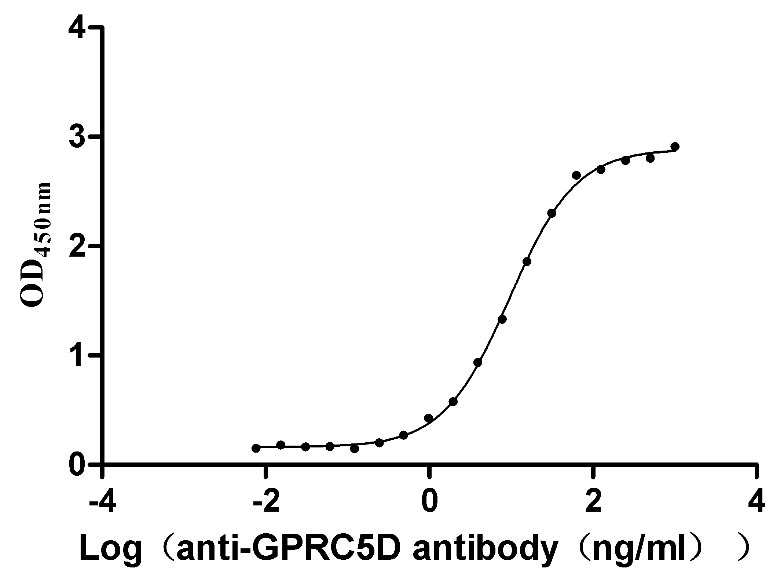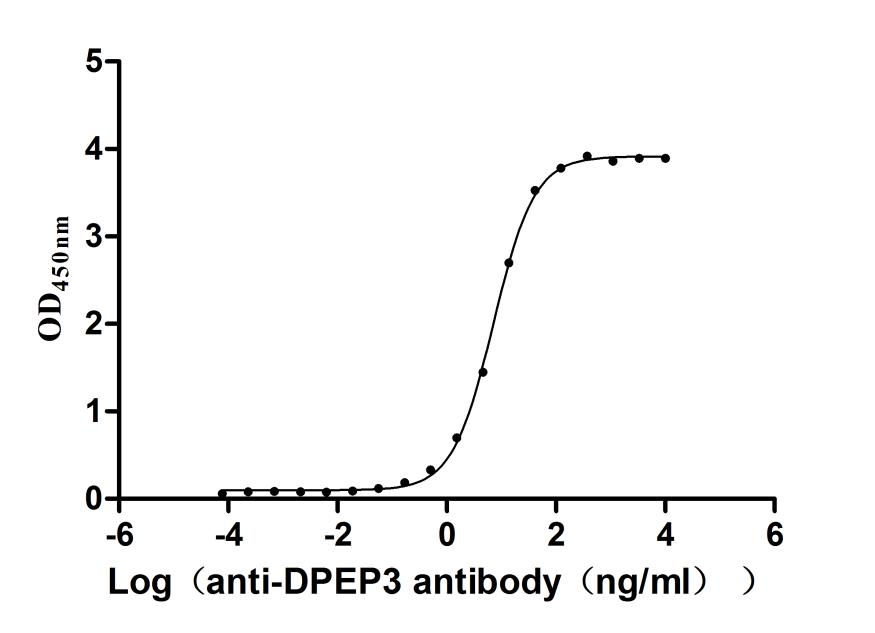Recombinant Mouse Calcium-dependent secretion activator 1 (Cadps), partial
-
中文名稱:Recombinant Mouse Calcium-dependent secretion activator 1(Cadps) ,partial,Yeast
-
貨號:CSB-YP767311MO
-
規(guī)格:
-
來源:Yeast
-
其他:
-
中文名稱:Recombinant Mouse Calcium-dependent secretion activator 1(Cadps) ,partial,Yeast
-
貨號:CSB-EP767311MO
-
規(guī)格:
-
來源:E.coli
-
其他:
-
中文名稱:Recombinant Mouse Calcium-dependent secretion activator 1(Cadps) ,partial,Yeast
-
貨號:CSB-EP767311MO-B
-
規(guī)格:
-
來源:E.coli
-
共軛:Avi-tag Biotinylated
E. coli biotin ligase (BirA) is highly specific in covalently attaching biotin to the 15 amino acid AviTag peptide. This recombinant protein was biotinylated in vivo by AviTag-BirA technology, which method is BriA catalyzes amide linkage between the biotin and the specific lysine of the AviTag.
-
其他:
-
中文名稱:Recombinant Mouse Calcium-dependent secretion activator 1(Cadps) ,partial,Yeast
-
貨號:CSB-BP767311MO
-
規(guī)格:
-
來源:Baculovirus
-
其他:
-
中文名稱:Recombinant Mouse Calcium-dependent secretion activator 1(Cadps) ,partial,Yeast
-
CSB-MP767311MO
-
規(guī)格:
-
來源:Mammalian cell
-
其他:
產(chǎn)品詳情
-
純度:>85% (SDS-PAGE)
-
基因名:Cadps
-
Uniprot No.:
-
別名:Cadps; Caps; Caps1; Kiaa1121; Calcium-dependent secretion activator 1; Calcium-dependent activator protein for secretion 1; CAPS-1
-
種屬:Mus musculus (Mouse)
-
蛋白長度:Partial
-
蛋白標(biāo)簽:Tag?type?will?be?determined?during?the?manufacturing?process.
The tag type will be determined during production process. If you have specified tag type, please tell us and we will develop the specified tag preferentially. -
產(chǎn)品提供形式:Lyophilized powder
Note: We will preferentially ship the format that we have in stock, however, if you have any special requirement for the format, please remark your requirement when placing the order, we will prepare according to your demand. -
復(fù)溶:We recommend that this vial be briefly centrifuged prior to opening to bring the contents to the bottom. Please reconstitute protein in deionized sterile water to a concentration of 0.1-1.0 mg/mL.We recommend to add 5-50% of glycerol (final concentration) and aliquot for long-term storage at -20℃/-80℃. Our default final concentration of glycerol is 50%. Customers could use it as reference.
-
儲存條件:Store at -20°C/-80°C upon receipt, aliquoting is necessary for mutiple use. Avoid repeated freeze-thaw cycles.
-
保質(zhì)期:The shelf life is related to many factors, storage state, buffer ingredients, storage temperature and the stability of the protein itself.
Generally, the shelf life of liquid form is 6 months at -20°C/-80°C. The shelf life of lyophilized form is 12 months at -20°C/-80°C. -
貨期:Delivery time may differ from different purchasing way or location, please kindly consult your local distributors for specific delivery time.Note: All of our proteins are default shipped with normal blue ice packs, if you request to ship with dry ice, please communicate with us in advance and extra fees will be charged.
-
注意事項(xiàng):Repeated freezing and thawing is not recommended. Store working aliquots at 4°C for up to one week.
-
Datasheet :Please contact us to get it.
靶點(diǎn)詳情
-
功能:Calcium-binding protein involved in exocytosis of vesicles filled with neurotransmitters and neuropeptides. Probably acts upstream of fusion in the biogenesis or maintenance of mature secretory vesicles. Regulates catecholamine loading of DCVs. May specifically mediate the Ca(2+)-dependent exocytosis of large dense-core vesicles (DCVs) and other dense-core vesicles by acting as a PtdIns(4,5)P2-binding protein that acts at prefusion step following ATP-dependent priming and participates in DCVs-membrane fusion. However, it may also participate in small clear synaptic vesicles (SVs) exocytosis and it is unclear whether its function is related to Ca(2+) triggering.
-
基因功能參考文獻(xiàn):
- findings suggest that CAPS1 stabilizes the state of readily releasable synaptic vesicles, thereby enhancing neurotransmitter release at hippocampal synapses. PMID: 27545744
- edited CAPS1 bound preferentially to the activated form of syntaxin-1A, a component of the exocytotic fusion complex. PMID: 27851964
- CAPS1 protein plays an important role during protein release from secretory granules in hippocampal neurons. The cytosolic protein CAPS1 regulates several stages of secretory granule processing. PMID: 26869227
- identified a specific interaction of CAPS1 with septin family proteins; demonstrated that the C-terminal region of the CAPS1 protein binds to part of the deduced GTP-binding domain of septin proteins. PMID: 26917099
- data indicate that CAPS-1 promotes fusion competence of immobile (tethered) DCVs in presynaptic terminals and that CAPS-1 localization to DCVs is probably not essential for this role PMID: 25719439
- Naturally occurring splice variants of CAPS2 in CAPS1/CAPS2-deficient cells were studied and found that CAPS2 primes vesicles independently of its MUN domain. PMID: 25437547
- Loss of CAPS1 disrupts the trans-Golgi network-dense-core vesicle pathway. PMID: 24174665
- CAPS family proteins exert dual roles in DCV trafficking, mediating trafficking at both the secretion site for exocytosis and at the Golgi complex for biogenesis PMID: 22111578
- a functional role for CAPS1 in regulating DCV trafficking in the trans-Golgi network; this activity occurs via protein-protein interaction with ARF4/ARF5 in a GDP-dependent manner. PMID: 20921225
- CAPS1 has a role in constitutive and regulated exocytosis but not in loading of transmitters into dense core vesicles PMID: 17540763
- Data demonstrate that CAPS-1 and -2 generate and maintain a highly fusion competent synaptic vesicle pool that supports phasic Ca(2+) triggered release of transmitters. PMID: 18022372
- Although CAPS1 proteins are not required for Ca(2+)-dependent exocytosis to proceed, they exert a modulatory effect on insulin granule priming, exocytosis, and stability. PMID: 18177725
- CAPS proteins are involved in optimizing vesicular monoamine uptake and storage mediated by VMAT1 and VMAT2 PMID: 19008227
- CAPS activity in priming vesicle exocytosis requires CK2 phosphorylation PMID: 19460754
- The two CAPS family proteins are complementarily distributed throughout the various brain regions of mice. PMID: 16506193
顯示更多
收起更多
-
亞細(xì)胞定位:Cell junction, synapse. Cytoplasmic vesicle, secretory vesicle, neuronal dense core vesicle membrane; Peripheral membrane protein.
-
組織特異性:Present in brain and adrenal glands (at protein level). Specifically expressed in neural and endocrine secretory tissues. Strongly expressed in almost all nerve cells of the brain, although it is absent from glial cells. Expressed in the cardiac atria, bu
-
數(shù)據(jù)庫鏈接:
Most popular with customers
-
Recombinant Human G-protein coupled receptor family C group 5 member D (GPRC5D)-VLPs (Active)
Express system: Mammalian cell
Species: Homo sapiens (Human)
-
Recombinant Human Somatostatin receptor type 2 (SSTR2)-VLPs (Active)
Express system: Mammalian cell
Species: Homo sapiens (Human)
-
Recombinant Human Claudin-9 (CLDN9)-VLPs (Active)
Express system: Mammalian cell
Species: Homo sapiens (Human)
-
Recombinant Human V-set and immunoglobulin domain-containing protein 4 (VSIG4), partial (Active)
Express system: Mammalian cell
Species: Homo sapiens (Human)
-
Recombinant Human Dipeptidase 3(DPEP3), partial (Active)
Express system: Mammalian cell
Species: Homo sapiens (Human)















